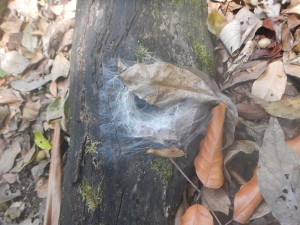We spent the whole day in the classroom today in order to finish up our project and some presentations and still be able to go on a night hike.
We wrapped up our nitrogen attraction experiment by counting all the arthropods and others in our urine and the water and finding the proportion. I had so many arthropods in my ground urine, but not in my tree urine. I found a very interesting spider related to a daddy long legs which had interesting markings on its back. It was about 1cm in body length. I nicknamed it the Leg Warmer Spider.

During the night hike it was a fabulous time for arachnids. We saw hundreds of wolf spiders and thousands of little spiders in the leaf litter which were too fast to get a look at. We saw one huge tarantula which was about 12 ft. up on a strangler fig. It was cinnamon-y in color, and probably a female of one of the species that have been described around here.
We also saw a huge black spider that was about 4-5cm in body length on the ground in some leaf litter off the trail. Its legs were bent so it was standing very tall off the ground. We looked for scorpions under almost every log along the train and did not find any. I wanted to see one under the black light cause they glow!
I think we also saw the leg warmer spider that I had named in class earlier. Its markings on its back were very similar and it was the same size. The markings themselves glowed in the black light.
Other than the arachnids, we saw some huge cockroaches and one of them excreted glue when we picked it up and it hissed. Sam didn’t even drop it. Also we found this huge cockroach that was as big as my hand and Adrienne overcame her fear and touched it.










